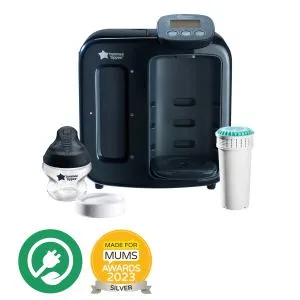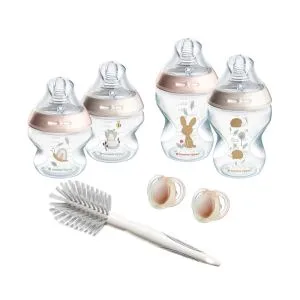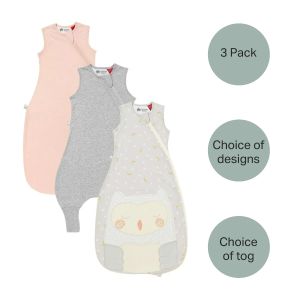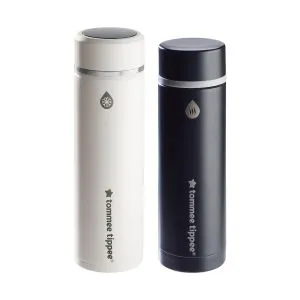
Tommee Tipps
We've created a handy step-by-step bottle feeding guide to help you get started.
How to Bottle Feed a Baby
If you've never bottle fed a baby before, you might find the idea of it a little daunting. Don’t worry, many parents bottle feed their babies either breast milk or formula, and after the first few feeds, you’ll wonder what you were so nervous about.
We've created a handy step-by-step bottle feeding guide for new parents to help you get started.
What equipment do you need for bottle feeding?
When you're getting ready to bottle feed, you'll need several bottles, teats, a bottle brush, some sterilising equipment and perhaps a breast pump.
Head to our baby feeding glossary to learn more about what you'll need to feed.
How many bottles and teats do I need for a newborn?
Knowing how often you plan to bottle feed can help determine how many teats and bottles you'll need.
If you’re only going to use bottles once a day or just occasionally, having two is a good idea. That way, if one is lost, damaged or needs to be cleaned, you've got a backup.
But, if you're solely bottle feeding a newborn, then you should have around four to six bottles and teats because newborns can feed up to 12 times over 24 hours!
Best practice sterilising techniques when bottle feeding
Sterilising your baby’s bottles and feeding equipment thoroughly before each use is a must. It protects them from infections (especially while their immune system is still developing). Failure to sterilise can lead to stomach upsets like diarrhoea.
Before sterilising your baby’s bottles, be sure to give them a scrub with warm soapy water to get rid of any milk residue. It's recommended that anything that goes into a baby's mouth is sterilised for the first 12 months of their life.
Making up the bottle with formula or breast milk
If you're bottle feeding, you'll either be giving your baby expressed breast milk or formula milk, or feeding using both (but not at the same time in the same bottle). This is sometimes called mixed or combination feeding. The NHS has lots of information about mixed feeding.
How to make up a bottle with breast milk
If you're going to give your baby breast milk in a sterile bottle, you'll need a breast pump or to be able to express by hand, and some sterile pouches to store your expressed milk in the fridge or freezer.
How to make up a bottle with infant formula
Follow the preparation instructions of the infant formula you're using carefully, and always use sterile water that's been boiled and left to cool.
It's worth noting that too much water can dilute the formula, meaning your baby won’t get the optimal amount of nutrition from their feed. On the flip side, too much formula can lead to constipation and dehydration.
Only make up a formula feed when needed, and make one feed at a time, never in bulk. Our Perfect Prep™ machines can help to take the fuss out of preparing a bottle.
Follow these bottle feeding tips
Let's run through some helpful tips to bear in mind when bottle feeding.
Six is the magic number
If your baby isn't taking to their bottle right away, it can be tempting to keep buying and trying until you find one they accept, but the truth is, six tries of the same bottle is likely to be as successful as trying six different bottles. Don’t be disheartened and try to persevere with the bottle you think is closest to a breast in shape and movement.
Always check the temperature of the milk
If your baby likes a warm bottle, use the inside of your wrist to test a few drops. If it’s a comfortable temperature, you’re good to go!
While lots of babies like their feeds at body temperature, it's worth noting that not all babies need their milk to be warm. You can try them with cool milk first to see if they'll take it. This may make things easier when you're out and about!
Make sure you’re both sitting comfortably
Little ones who're bottle fed lying down can take too much milk too quickly, so it’s important to sit with them in a semi-upright position close to you. Supporting their head is really important and means that they can swallow and breathe comfortably.
Remember, never leave your baby alone to feed with a propped-up bottle as they may choke on the milk.
Gently introduce the teat
Brushing your baby's lips with the bottle teat stimulates their gaping or mouth-opening reflex. Once they've opened their mouth wide, you should let them draw in the teat at their own pace.
Hold the bottle horizontally
Once the teat is in baby’s mouth, keep the bottle tipped in a horizontal position so that the milk can flow steadily. This helps prevent baby from taking in air, and means that they need to suck actively to get the milk like they would when breastfeeding.
Always tilt the bottle so the teat is full of milk. You’ll need to tip it higher as the bottle slowly drains.
If you notice that the teat goes flat mid-feed, just gently pull on the corner of baby's mouth to release their latch, and replace it with a new sterile teat if it gets blocked.
Follow baby’s cues
The truth is, some little ones want to feed more often than others, and your baby will let you know how much milk they need. It's best to feed your baby when they seem hungry. Follow their lead and don’t worry if they don’t finish their full bottle. This is often called paced bottle feeding.
Talk and sing to baby
Talking and singing to your little one while bottle feeding creates a really powerful emotional bond with them, even from a young age.
Always discard unused milk
You should discard any unused milk that's left over after a feed. It may seem wasteful, but it's safer for your baby because bacteria can get into the milk while they feed and damage their delicate immune system.
Bottle feeding: Parents' stories
Looking back Gianni believes that "the truth about bottle feeding, is that it's ok. Regardless of if you nurse directly, pump and feed using a bottle or formula feed, it is ok. If your baby is healthy, growing and thriving, it is ok."
And Sarah told us that "the truth is, bottle feeding allowed [her] to build a bond with [her] daughter. [Her] wife breastfeeds her, and [she] takes the opportunity every evening to feed her using a bottle to have some extra one-on-one time."
The benefits of bottle feeding
Now that we've covered what you'll need to bottle feed, let's run through some of the benefits of bottle feeding.
Eye and skin-to-skin contact for both parents
Bottle time might be the calmest part of your day with your little one, so soak it up. Make sure that you can see your baby's face and reassure them by looking into their eyes.
Maintaining skin-to-skin contact releases the love hormone oxytocin. It’s a great way to bond with your baby while improving their non-verbal communication skills.
Non-breastfeeding parents and other adults who hold and feed the baby can also experience enjoy the feel-good nurturing hormones. According to UNICEF, skin-to-skin contact also:
- calms baby
- regulates their breathing and heart rate
- stimulates interest in feeding
- supports digestion
- helps regulate their temperature
- enables colonisation of the baby's skin with the mother's friendly bacteria and protects against infection.
It gives breastfeeding parents a break
Baby’s other parent, as well as family and friends, get some one-on-one time with them. Bottle feeding also means that the breastfeeding parent has some time to rest, pump, or recover if they're struggling with nipple soreness, clogged ducts or mastitis.
You can see exactly how much baby has drank
This is ideal if baby needs to gain weight and you’re monitoring feeds.
What are the disadvantages of bottle feeding?
- Bottle feeding can be more expensive than breastfeeding, especially if the baby requires a special type of formula.
- Formula doesn't provide the same kind of nutrients and antibodies that breast milk does.
- There's more equipment to clean and sterilise.
- You need to prepare for feeds away from home.
- Some babies may have difficulty adjusting to bottle feeding and may experience digestive issues such as trapped wind, constipation, or diarrhoea.
Advice for bottle feeding a breastfed baby
There're a few reasons why parents of breastfed babies choose to introduce a bottle alongside or to replace direct breastfeeding. It’s a very personal choice that should be guided by what's best for both parent and baby.
If you've previously been breastfeeding your baby and want to introduce a bottle into your feeding routine, it can help to give your little one time to become familiar with the feel of the bottle teat.
It’s best to take your time and be patient, because taking things too fast can lead to baby refusing their bottle altogether.
How do I know my baby has had enough milk?
Watch them carefully and look out for cues that signal that they may be feeling full or uncomfortable. These include:
- splaying their fingers and toes
- wrinkling their forehead
- spilling milk out of their mouth
- turning their head away
- pushing the bottle away.
If they do need a break, just gently remove the teat, and bring the bottle down to cut off the flow of milk until they ask for more milk. If they don’t ask for more, they’ve probably had enough for now.
Overfeeding can cause distress and trying to bottle feed a crying baby means they could potentially choke. So, try not to make the mistake of assuming that your baby is hungry every time they cry. Other reasons your baby might be crying can include:
- needing to be burped
- needing their nappy changed
- being tired or generally irritable
- needing comfort and cuddles.
How often to bottle feed a newborn
The truth is, every baby is different, and so the frequency of feeds needed varies from one baby to the next. But generally, it’s recommended that newborns feed little and often and that parents should look for their baby’s hunger cues and try to feed them before they start crying.
How often should I check the teats on my baby's bottles?
Your beautiful newborn's soft gums won’t stay that way forever! Soon teeth will arrive, and you'll need to check your teats for signs of biting. You should change your teats every two months or immediately if they're damaged, weak, or have been bitten.
Your baby will usually let you know when it’s time to change flow rate, or even if you’ve moved up too quickly.
Signs that it’s time to move up a teat flow rate include your baby:
- becoming impatient or aggravated when eating
- taking longer than 20 minutes to finish a feed
- falling asleep while feeding
- sucking hard and/or the teat collapsing in on itself.
Signs that the flow rate of the teat you’re using is too fast include your baby:
- gulping or hard swallowing
- coughing or choking
- letting excess milk drip out of their mouth
- refusing to eat.
Bottle feeding resources
Whether you've chosen formula or expressed breast milk (or a combination of both), we know that getting used to bottle feeding can be quite overwhelming for some parents. It can help to talk to your midwife, health visitor or fellow parents for further guidance and support.
Here are some organisations that can help:
- NCT's infant feeding support line offers free advice and information from trained counsellors. They also have a YouTube channel with bottle feeding advice videos.
- UNICEF offer a simple, concise overview of how to bottle feed responsively. They also provide advice on choosing infant formula.
Bottle feeding FAQs
Is bottle feeding okay for newborns?
Although the WHO recommends exclusive breastfeeding for the first six months of life, the decision to bottle feed or breastfeed is a personal choice. Babies can be bottle fed from birth if they're unable to breastfeed or you choose not to for whatever reason.
Whichever feeding method you choose, the decision should be made in consultation with a healthcare provider.
Can you overfeed a newborn?
It is possible to overfeed a bottle-fed baby, but overfeeding is rare and can be easily prevented. You can find out more in our dedicated guide on overfeeding a baby.
Why is my newborn still hungry after feeding?
There could be a few reasons why your newborn is still hungry after feeding. They may not be getting enough milk during each feeding, or they may be cluster feeding.
It's also possible that they have a medical issue that's affecting their appetite. It's always a good idea to talk to your paediatrician or midwife if you have any concerns about your baby's feeding habits.
How do I wind my baby after bottle feeding?
Sometimes babies take in air bubbles as they feed which get trapped, cause discomfort, and can develop into colic. Burping them can help to relieve their discomfort.
Give the following winding techniques a go:
- Over your shoulder: With their chin on your shoulder, support their head and shoulder area with one hand, and gently rub or pat their back with the other.
- Sitting on your lap: Sit your baby on your lap facing away from you. Place the palm of your hand flat against their chest and support their chin and jaw (don't put any pressure on the throat area). Lean them forward slightly and gently rub or pat their back with your other hand.
- Lying across your lap: Lie your baby face-down across your lap. Support their chin (don't put any pressure on the throat area) and use your other hand to gently rub or pat their back.
If the above techniques don't work and they still show signs of trapped wind – crying, arching their back, drawing their legs into their tummy, or clenching their fists – you can lie them on their back and gently massage their tummy or move their legs in a bicycle motion.
Are Tommee Tippee bottles suitable for newborns?
Yes, Tommee Tippee bottles are suitable for newborn babies.
Sources
- Introducing a Bottle to a Breastfed Baby - La Leche League International (llli.org)
- Bottle-feeding basics - BabyCentre UK
- 10 bottle-feeding tips for breastfed babies | Baby & toddler, Feeding articles & support | NCT
- Step-by-step guide to preparing a formula feed | Baby & toddler, Feeding articles & support | NCT
- Sterilising baby bottles - NHS (www.nhs.uk)
- How to make up baby formula - NHS (www.nhs.uk)
- How to combine breast and bottle feeding - NHS (www.nhs.uk)
- Formula milk: common questions - NHS (www.nhs.uk)











